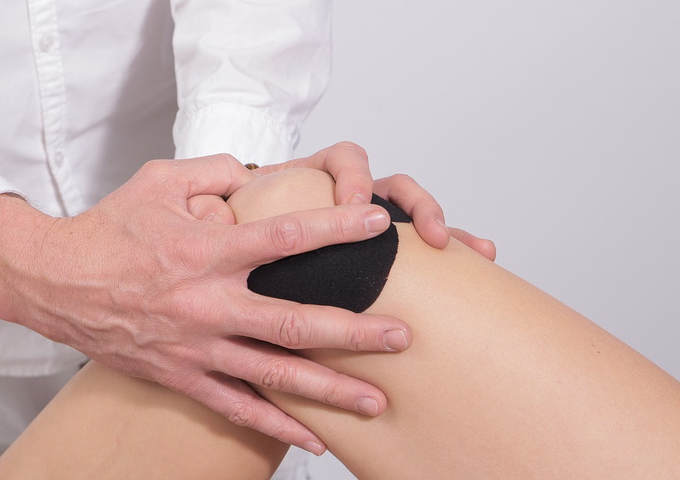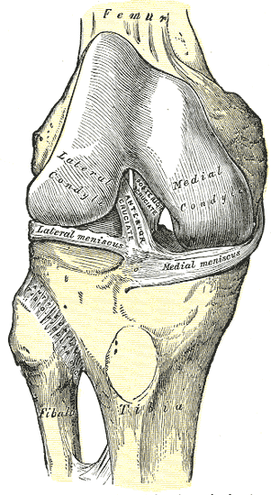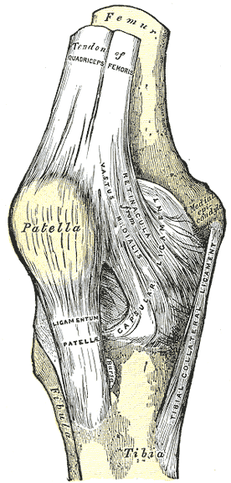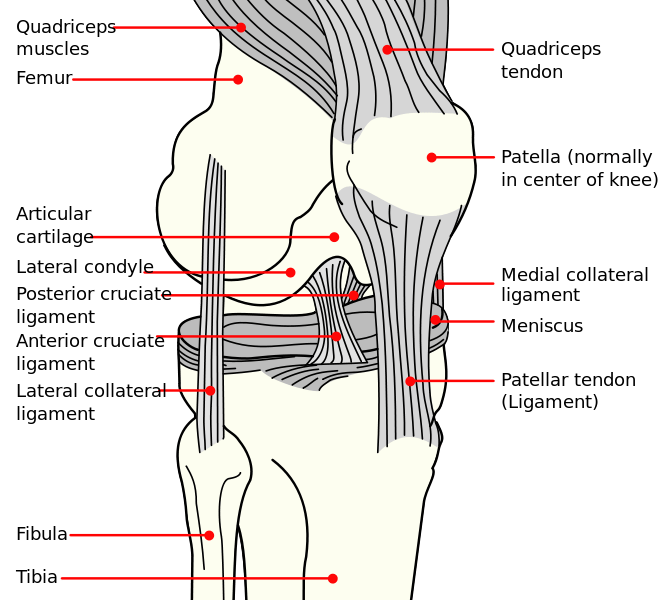OSGOOD SCHLATTER’S SYNDROME
Michael developed Osgood Schlatter’s “Disease” (the medical community’s word, not mine) as an adolescent and had struggled with severe knee and leg pain clear through school and into adulthood. His case was classic. He had the huge (really huge) Tibial Tubercles on both knees that were so pain sensitive, merely ‘bumping’ them would make him nearly pass out. It had affected both his ability to play sports as well as his ability to work.
The day before he was to leave for boot camp, he came to see me and I found out about it for the very first time. So, I treated him — one time —- seven or eight years ago —– for a problem he had struggled with for the better part of his life. Needless to say, the one treatment solved his problem and it never returned. Thanks for the memories Michael (not to mention the testimonial)!
Try asking several doctors what Osgood Schlatter Syndrome is. They will tell you that it is knee pain in children and adolescents. Better yet, ask them what causes it. If they do not repeat the same answer they just gave, you will most likely be told that nobody knows. But this is not really true. Wikipedia says this about the cause of Osgood Schlatter Syndrome:
|
|
“The condition is caused by stress on the patellar tendon that attaches the quadriceps muscle at the front of the thigh to the tibial tuberosity. Following an adolescent growth spurt, repeated stress from contraction of the quadriceps is transmitted through the patellar tendon to the immature tibial tuberosity. This can cause multiple subacute avulsion fractures along with inflammation of the tendon, leading to excess bone growth in the tuberosity and producing a visible lump which can be very painful when hit. In more detail, activities such as kneeling may irritate the tendon.“
|
|
Honestly, Wikipedia nailed it.
OSGOOD SCHLATTER is a condition seen in children and adolescents who have gone through a growth spurt and are involved in youth athletics. But let me break the whole thing down for you into language that may be a bit easier to digest. If you look at the picture on the right you will see the the knee cap (Patella). The tendon above the knee cap is the Quadriceps Tendon.
Front View Tibial Tubercle with Quadriceps Tendon and Patellar Tendon Removed
|
Front View with Patellar Tendon and Quadriceps Tendon Intact
|
MORE PICTURES OF OSGOOD SCHLATTER SYNDROME
|
|
The picture on the left shows the front right thigh (Quadriceps Muscles). These (4) muscles make up the most powerful group of muscles in the entire body. And although these four muscles have upper attachments that range from the pelvis to the thigh bone itself (femur), the lower attachment is the same for all of them. It is the Quadriceps Tendon. Just below the Quadriceps tendon is the short Patellar Tendon which attaches to the lower leg at a place called the Tibial Tuberosity. If you simply reach down and feel
|
fabout an inch below your knee cap, you will feel this ‘knob’ of bone. As you can imagine, there is a huge amount of mechanical stress at this single point. That is why there is a knob there in all of us. The problem is that there are certain things that can make that knob grow.
Wolf’s Law says that,”Bone grows due to mechanical stresses placed upon it, whether the stresses are normal (good) or abnormal (bad)“. This is valuable information. It is why people who have broken a leg are put in a walking cast as soon as they can tolerate it. It is also why people develop Degenerative Arthritis in joints that have been injured or do not ‘move’ like they used to move. Abnormal mechanical stresses on muscles, tendons, joints, or bones, are going to cause problems in one way or another.
Let’s think about this for a moment. What is one result an overly tight quadriceps muscle is going to produce? It is ultimately going to pull like crazy at the Tibial Tubercle. If you understand Wolf’s Law, you realize that this is going to cause the Tibial Tubercle to increase in size as new bone is laid down. As the earlier quote from Wikipedia says, “repeated stress from contraction of the quadriceps is transmitted through the patellar tendon to the immature tibial tuberosity.“ When this happens, you will get varying degrees of, “avulsion fractures along with inflammation of the tendon, leading to excess bone growth in the tuberosity and producing a visible lump.“ In the case of Osgood Schlatter Disease, there will always be a degree of TENDINOSIS. However, treatment that is geared at the tendon itself will frequently fail —- especially in more severe cases. The tendon problem, the repeated avulsion fractures, and the extra-large Tibial Tuberosity all have an underlying cause.
In the case of these “Avulsion Fractures”, there is so much mechanical stress at the point where the Patellar Tendon anchors into the Tibial Tuberosity, that it not only causes the Tuberosity itself to grow increasingly larger (Wolf’s Law), it actually causes tiny chunks of bone to be pulled away from the tubercle. In the pictures below, you can see what these Avulsion Fractures look like on an x-ray. This might be why the ‘official’ medical terminology for Osgood Schlatter Disease is to refer to it as a Tibial Tubercle Apophyseal Traction Injury
. This is actually much more descriptive than naming it after the two guys who ‘discovered’ it — and then throwing the word “
Disease” on the end. Just like I wrote about a couple of weeks ago when discussing the relatively new terminology
DEGENERATIVE JOINT DISEASE, Osgood Schlatter cannot really be considered a disease. It is the result of an underlying mechanical problem.
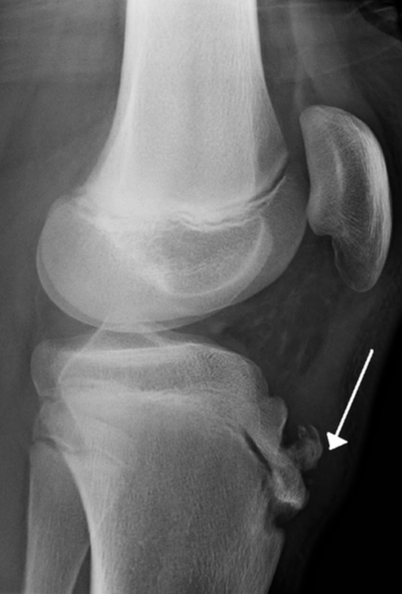
Image by James Heilman MD
|
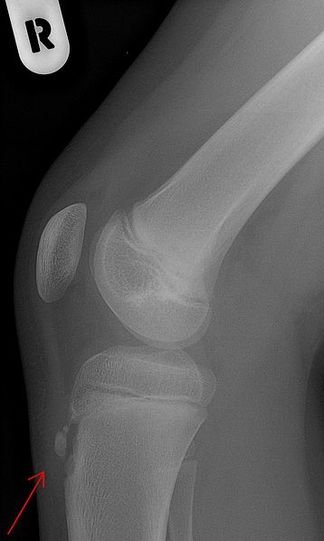
Image by Lucien Monfils
|
Many mechanical problems (including OS) can be fixed if you know what to look for and catch them before they degenerate. But then again, you have to really know what to look for. The problem is that the medical community seems to be stuck in the dark ages in dealing with Osgood Schlatters. Again quoting from Wikipedia, “treatment is conservative with RICE (Rest, Ice, Compression, and Elevation), and if required acetaminophen (paracetamol), ibuprofen and/or Co-Codamol or stronger if in ‘acute phase’ & (the pain is severe and continuous in nature)….. Bracing or use of an orthopedic cast to enforce joint immobilization is rarely required and does not necessarily give quicker resolution. In approximately 10% of patients the symptoms continue unabated into adulthood, despite all conservative measures. Surgical excision may rarely be required in skeletally mature patients.” I think that this quote shows how backwards the thinking is concerning the manner in which our medical community addresses mechanical issues. This protocol simply does not help a large percentage of the people suffering with Osgood Schlatter’s!
If you have a mechanical problem in your vehicle, you cannot fix it chemically. The same thing is true with your house, or for that matter, with
anything that is mechanical. The same thing is just as true in dealing with the human body. Mechanical and chemical are largely incompatible. In other words, you cannot simply prescribe pain pills and anti-inflammatory meds (chemicals), and hope to get good results with mechanical problems like Osgood Schlatter Syndrome. Covering symptoms without addressing the underlying cause(s) of the symptoms is going to lead to future problems. Not the least of which is
DEGENERATIVE ARTHRITIS. This is really quite easy to understand. Whether or not you have pain right now; joints that are not functioning like God intended them to function, wear out and degenerate (this loss of function is often very subtle and at least at first, unnoticeable). And when that happens your doctor can solemnly look at you and say, “
Mr. Smith, you’re just not as young as you used to be. It’s time to replace your knee.” Drugs and surgery are
not needed to effectively deal with Osgood Schlatter’s Syndrome. For those dealing with Tendinosis at multiple sites bilaterally, rest assured that you have an underlying
AUTOIMMUNITY issue.
To the best of my knowledge, I have never seen a case of Osgood Schlatter Syndrome that I was unable to resolve —- quickly. The thing that I find somewhat odd, however, is that despite the fact that it is dog-common, few people have heard of it and the medical community has no real idea how to address it other than the methods mentioned above. If you or a loved one has Osgood Schlatter’s, call Tracy at (417) 934-6337 and schedule an appointment to let me take a look. Dealing with this common mechanical problem now, can potentially save a lot of time, grief, and money in the future. We will never make that ugly over-sized Tibial Tubercle go away —- no one can. Unfortunately, it will be with you forever. But we can stop the abnormal bio-mechanics that are causing it to grow, as well as helping prevent future knee problems. It is my experience that doing this will stop the pain of Osgood Schlatter Disease dead in its tracks!

